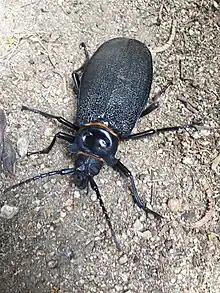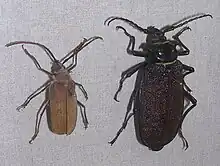| Acanthinodera | |
|---|---|
 | |
| Scientific classification | |
| Domain: | Eukaryota |
| Kingdom: | Animalia |
| Phylum: | Arthropoda |
| Class: | Insecta |
| Order: | Coleoptera |
| Infraorder: | Cucujiformia |
| Family: | Cerambycidae |
| Subfamily: | Prioninae |
| Tribe: | Macrodontiini |
| Genus: | Acanthinodera Dupont 1835 |
| Species: | A. cumingii |
| Binomial name | |
| Acanthinodera cumingii Hope, 1833 | |
| Synonyms[1] | |
|
List
| |
Acanthinodera is a genus of longhorned beetles in the family Cerambycidae.[1] It is monotypic, being represented by the single species Acanthinodera cumingii.[2] It is the largest species of beetle in Chile.[3] The beetle is endemic to central Chile and can be found from IV Coquimbo Region to IX La Araucanía Region.
Description

The species has a particularly marked sexual dimorphism,[4] which originally led naturalists to classify the male and female as distinct species. The male measures 5–6 cm, is light brown and furry. The female is black and measures between 8–9 cm on average, although specimens exceeding 12 cm in length have also been found. The male is nocturnal and can fly, but the female is diurnal and does not fly.[5]
The insects produce a hissing sound when disturbed that they generate by rubbing their rear legs along the edge of the wing covers. Although they are slow-moving and non-aggressive, they can deliver a powerful bite if provoked. Their legs are powerful and tipped with large claws, they are very difficult to remove from surfaces on which they can gain good purchase; this includes tree bark, clothes and skin.
Distribution
The species is endemic to Chile, and can be found from the south of the Region of Coquimbo to the Malleco Province in the Region of Araucanía. It can be found from sea level to the Precordillera hills.[6]
Life cycle
The life cycle of A. cumingii has been little studied. The females lay more than 100 white eggs resembling grains of rice in the dry trunks of trees and in decomposing vegetation.[3] The length of time between eggs and adulthood can take six years, depending on humidity and food availability.[6] Larva can reach sizes as large as 13 cm in length.[4][7] For this reason the common name of the insect is "the mother of the snake" in Spanish.
The insect plays an important ecosystem role in decomposition of dead wood. The larval stage has been found living in approximately 30 species of trees, both indigenous and invasive. This includes Eucalyptus which is an invasive tree in Chile.[6]
Threats
The insects are occasionally preyed upon by mammalian carnivores, such as foxes. However, the strong jaws of the insect, used for eating wood, may provide a defense.[5]
Conservation
In its native habitat in Chile the insect is vulnerable to habitat destruction from logging and construction.[4] Due to its large size, the beetle is also vulnerable to being caught and killed by people, exacerbating the danger of extinction.
References
- 1 2 "Catalog of Life: Acanthinodera cummingi Gazulla & Ruíz, 1929". www.catalogueoflife.org. April 2015. Archived from the original on November 14, 2016. Retrieved November 13, 2016.
- ↑ Bezark, Larry G. A Photographic Catalog of the Cerambycidae of the World Archived 2013-08-27 at the Wayback Machine. Retrieved on 22 May 2012.
- 1 2 "FICHA DE ANTECEDENTES DE ESPECIE: Acanthinodera cummingi" (PDF). www.mma.gob.cl/. 2016. Retrieved November 17, 2016.
- 1 2 3 "Madre de la Culebra". www.surmagico.cl. Archived from the original on July 1, 2017. Retrieved November 13, 2016.
- 1 2 Zúñiga-Reinoso, Álvaro; et al. (2016). "Acanthinodera cumingii (Coleoptera: Cerambycidae) in the diet of carnivores of the Nahuelbuta Mountain Area, south-central Chile". Journal of Entomology and Zoology Studies. 4: 696–698.
- 1 2 3 Fuentes Olivares, Pablo; Araneda Olivares, Cristóbal (2016). "Primer registro de larva de Acanthinodera cumingii (Hope, 1833) (Coleoptera: Cerambycidae) en el arbusto invasor Ulex europaeus L.". Biodiversity and Natural History. 2: 1–5.
- ↑ Angulo, A (1974). "Endogamia, endemismo y teratología en insectos". Boletín de la Sociedad de Biología de Concepción. 47: 297–301.
External links
 Media related to Acanthinodera at Wikimedia Commons
Media related to Acanthinodera at Wikimedia Commons Data related to Acanthinodera at Wikispecies
Data related to Acanthinodera at Wikispecies